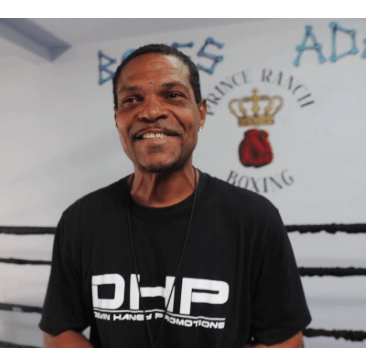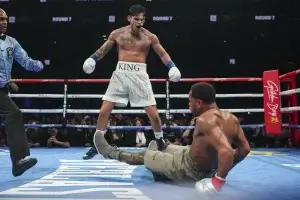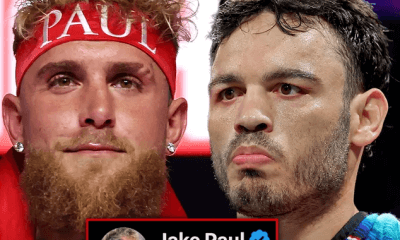Featured Articles
The Noted Trainer Kevin Henry, Lucky to Be Alive, Reflects on Devin Haney and More

This past summer, on July 21, Las Vegas boxing trainer Kevin Henry almost died. He was on the Las Vegas Strip, walking north from Caesars Palace, when he was the victim of an auto-pedestrian accident, hit by a careless uber driver exiting the Treasure Island casino after dropping off a passenger.
Henry suffered two broken bones in his neck, shoulder and hip displacements, lost two teeth, and had facial injuries that required plastic surgery. He spent three months in the hospital, the first 20 days in ICU and the final month at an in-patient rehabilitation facility.
The good news is that the pain has subsided and Kevin Henry is back in the gym mentoring boxers and enjoying the camaraderie of his peers.
Kevin, 55, grew up around the sport. His father, the late Norman Henry, was a fixture on the Philadelphia boxing scene going back to the late 1940s when he was Bob Montgomery’s Man Friday. The elder Henry co-managed Jeff Chandler and others and had a long association with Don King where he defined his role as that of a troubleshooter. Kevin was born in Philadelphia, spent several years in the LA area during the days when his father was a matchmaker for Harold Smith’s MAPS (an acronym for Muhammad Ali Professional Sports), and has been a full-time resident of Las Vegas since 1992.
“When I was 16, maybe 17, I was the youngest licensed second in New Jersey” says Henry. “In Philadelphia, I got to hang with great old-school trainers like George Benton. In LA, my home away from home was the Hoover Street Gym. Jackie McCoy, Eddie Futch, and Jesse Reid trained fighters there. A young trainer couldn’t ask for a better schoolhouse.
“The old-school trainers liked me because I was organized. If a kid said to me, oops, I forgot my gym bag or I can’t spar because I forgot my mouthpiece – and this happened a lot – I’d say, no you didn’t, I have it right here. And the kids knew if they went out and did something they shouldn’t have, that I wasn’t going to tattle-tale.”
When Henry moved to Las Vegas, the local heavyweight scene was percolating. Michael Dokes was here as were Oliver McCall and Michael Hunter Sr. The latter two fought each other as they were climbing the ladder and eventually became fast friends.
The ill-fated Hunter would become a member of the family. He married Kevin Henry’s sister. Michael Hunter Jr, a leading heavyweight contender whose victims include the white-hot Martin Bakole and Michael’s younger brother Keith Hunter, a 15-2 junior welterweight, are Kevin’s nephews.
Discounting Devin Haney’s father Bill, no boxing coach has spent more time in the company of Devin Haney. Henry was in Devin’s corner for the vast majority of his amateur bouts, including five of Devin’s six meetings with his great amateur rival Ryan Garcia, and their tie continued after Devin transitioned into a pro.
“He was like a little brother to me,” says Henry. “I remember the first day I saw him. It was at the old Round One gym which isn’t here anymore. A Rolls Royce pulled up out front. Derrick Harmon, who fought Roy Jones, was there with me. We figured that the person in the car was probably some famous professional athlete who had come to work up a sweat. But it was Bill Haney with his nine-year-old son. Neither Bill nor his kid knew anything about boxing; Bill wanted someone to teach Devin how to box. The boy was a blank canvas.
“Bill left and when he came back, he said, ‘how did he do?’ He was so proud when we told him his kid was a natural. Derrick and I couldn’t believe that the boy had never been in the gym before. We were amazed.”
The precocious Haney, who turned pro in Mexico at age 16, proved to be as good as advertised. He won the WBC world lightweight title in his twenty-fourth pro fight, pitching a shutout over previously undefeated Alfredo Santiago, went on to unify the title with wins over George Kambosos and Vasyl Lomachenko, and pitched another shutout in his first venture at 140, whitewashing Regis Prograis to capture another world title belt.
Kevin Henry was there for some of these fights and was lost in the shuffle at others. It remains a sore spot.
No active boxer has been looked-over by as many prominent trainers as Devin Haney. Bill Haney, who would be a finalist for both the 2023 BWAA Trainer of the Year and Manager of the Year, winning the latter, operated on the assumption that all had something useful to contribute and that from their inputs he could build something that was greater than the sum of its parts. He was bucking several bromides including the chestnut that too many chefs spoil the broth and that brings us to the night of April 20, 2024, when Bill Haney’s son caught up with his old amateur rival Ryan Garcia at Barclays Center in Brooklyn.
In a memorable fight, Garcia buzzed Haney in the opening minute of the match with his patented left hook and would then go on to dominate the second half of the fight, putting Haney on the canvas three times – in rounds 7, 10, and 11 – en route to a scorching upset.

As we know, Garcia, who came in three pounds overweight, would have the “W” stripped from him when his urine samples revealed the presence of a performance-enhancing drug, ostarine. The New York State Athletic Commission changed the result to a no-contest and that is how it appears at boxrec, the sport’s official record-keeper.
Devin Haney remains undefeated (31-0, 1 NC) but Ryan Garcia knocked the mystique out of him.
In part because of his tender age – he turned 26 earlier this month – Haney was considered a threat to break Floyd Mayweather’s 50-0 record. No one talks about that anymore and if it should happen, it would command an asterisk.
Kevin Henry was there at the Haney-Garcia fight but, in a sense, he wasn’t there.
“They never put my name on the comp list ” he says, “so there was no ticket or pass waiting for me when I got to the arena. I was actually on the subway heading back to my hotel when Devin called me. He said, ‘where you at ‘bro.’ When I explained the situation to him, he said ‘turn around and come back and go to security.’
“Devin arranged to have a ticket waiting for me. My seat was directly behind his corner. The undercard was already in progress when I got back.
“This will sound arrogant, but I am certain the outcome would have been different if Devin had a different corner. The most experienced guy in his corner that night was Bob Ware, and Bob isn’t a trainer; he’s a cutman. When Devin faced adversity for the first time in his life, there was no experienced head there to get him turned around.
“In preparation for Garcia, we spent 3-4 weeks at Freddie Roach’s Wild Card Gym. I actually suggested to Bill that he use Freddie in the corner. Freddie sees things that other trainers don’t see, even me, and Freddie would have known what adjustments to make. But Bill said no. He didn’t want to cede his authority.”
Kevin Henry’s admiration for Devin Haney, as a boxer and a person, hasn’t waned. “Ryan Garcia came in overweight at the weigh-in and you can just imagine how much weight he put on after he rehydrated. When they stood at center ring to get the referee’s instructions, Garcia looked like a middleweight to me. Devin dug deep and fought a great fight against a guy who was bigger and on steroids. One of the judges even had it a draw.” (True. Veteran arbiter Max DeLuca scored it 112-112. The other judges had Garcia winning by 4 and 6 points.)
As to what to expect from Devin when he returns, Henry says, “I worry about the mental part; some boxers don’t take losing well.” There are no such concerns about Kevin Henry who lost none of his mental acuity in that terrible accident and is back in his comfort zone.
Haney-Garcia photo credit: Cris Esqueda / Golden Boy Promotions
To comment on this story in the Fight Forum CLICK HERE
-

 Featured Articles4 weeks ago
Featured Articles4 weeks agoAvila Perspective, Chap. 330: Matchroom in New York plus the Latest on Canelo-Crawford
-

 Featured Articles3 weeks ago
Featured Articles3 weeks agoVito Mielnicki Jr Whitewashes Kamil Gardzielik Before the Home Folks in Newark
-

 Featured Articles7 hours ago
Featured Articles7 hours agoResults and Recaps from New York Where Taylor Edged Serrano Once Again
-

 Featured Articles4 weeks ago
Featured Articles4 weeks agoCatching Up with Clay Moyle Who Talks About His Massive Collection of Boxing Books
-

 Featured Articles5 days ago
Featured Articles5 days agoFrom a Sympathetic Figure to a Pariah: The Travails of Julio Cesar Chavez Jr
-

 Featured Articles3 weeks ago
Featured Articles3 weeks agoMore Medals for Hawaii’s Patricio Family at the USA Boxing Summer Festival
-

 Featured Articles7 days ago
Featured Articles7 days agoCatterall vs Eubank Ends Prematurely; Catterall Wins a Technical Decision
-

 Featured Articles4 weeks ago
Featured Articles4 weeks agoRichardson Hitchins Batters and Stops George Kambosos at Madison Square Garden




















